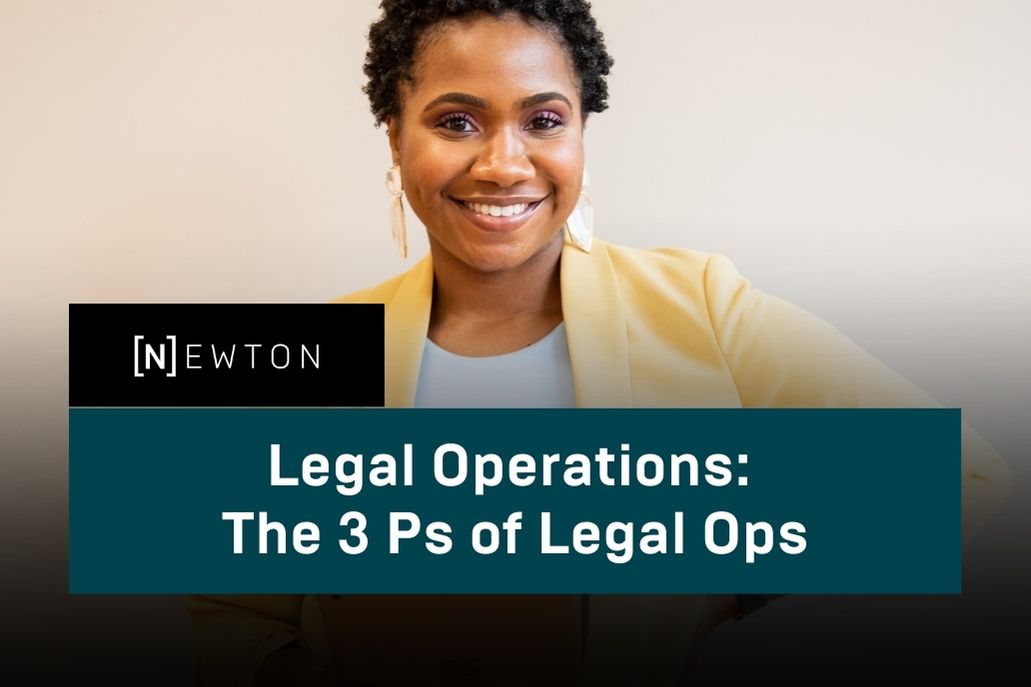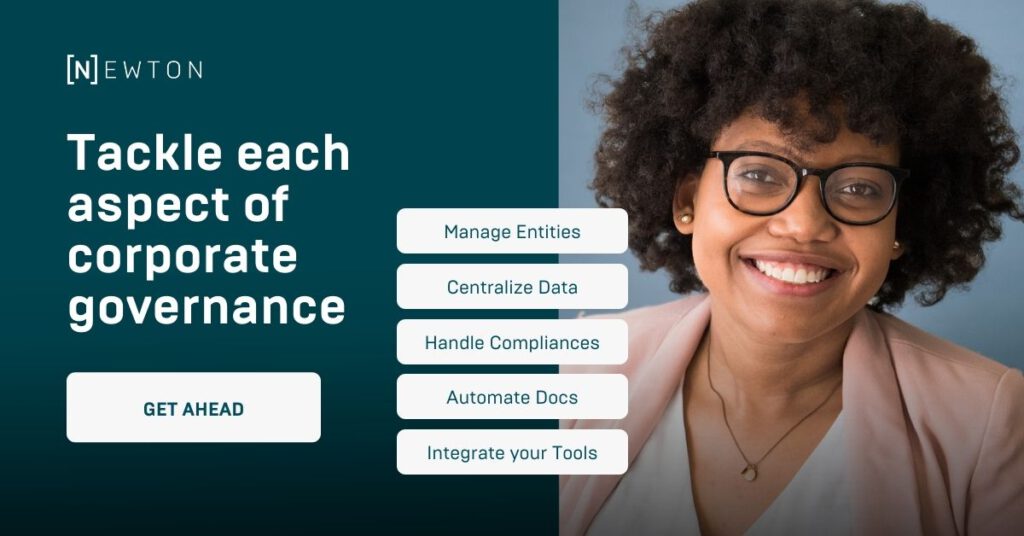
Legal operations can be overwhelming. From the CLOC core competencies and the ACC legal ops maturity model, this blog distills the topic into three main buckets.
Dear Legal Ops!
Welcome to this week’s Let’s talk about Legal Ops, offered by Newton. We tackle corporate legal departments, speed up processes, and career growth. Please send us your questions; in return, we come back with real insights and actionable tips.
If you find this post valuable, don’t miss the chance to check out our latest posts.
- Maximizing Transparency and Compliance with Legal Entity Management: The Power of Automated Visual Charts
- Getting SOC2 and ISO27001 ready
- How to build a culture of compliance
Subscribe to get access to more posts like these!
Join Newton’s newsletter to receive our blogs, templates, and the latest information right in your inbox. You can unsubscribe at any time.
Over the last five years or so, legal operations (or legal ops) has evolved from being a buzzword to an established legal function. Yet, this fast evolution hasn’t been without its growing pains.
Despite significant conversation around the topic, many legal professionals are yet to become confident in understanding and executing legal operation activities. And it’s not surprising; the vast array of terms and the growing expectations can be overwhelming.
While there are detailed frameworks to help structure legal operations – such as the CLOC 12 core competencies and the ACC legal operations maturity model – the vast legal ops landscape has left many legal professionals perplexed about where to start.
That said, in light of the current economic climate, there’s no arguing that legal operations and its efforts to streamline processes, improve productivity and better manage costs are needed more now than ever before.
So how can we simplify legal operations?
In this article, we will cover the following:
1. People
As with most business functions, it is people and human intelligence that enable any set of business activities and processes to deliver great legal results.
When it comes to people in a legal operations context, there are no official certification requirements. While a JD or MBA might prove helpful, there are other traits that make for a successful legal operations professional. Such qualities include;
- A strong understanding of the business and its objectives
- The ability to translate business priorities into a legal context
- Exceptional outside counsel management
- A belief that the legal function can act as a strategic growth enabler
There are two areas to focus on when thinking about people in a legal operations context.
Organizational optimization
The first, organizational optimization, is centered on the legal team, both at an individual level and a team level. This involves crafting and executing a strategic plan to build a streamlined, effective legal team.
Putting a focus on organizational optimization will see you strategically thinking about your hiring initiatives, building clear and motivational career paths, and developing your onboarding and offboarding processes. It even includes planning team-building activities to support the development of team morale and strong relationships, which, as a result, aid the team’s ability to execute projects effectively.
Knowledge management
Almost 30% of legal departments identified knowledge management as a weakness that was revealed during the pandemic.
Secondly, knowledge management and information governance are critical to ensure the sustainability and value-add of your legal function. You need to capture, distribute and effectively utilise a structured knowledge asset that supports your company’s compliance and operational requirements.
Don’t let the somewhat uninspiring term “information governance” fool you. This can be a real scalability enabler if set up and executed well. Developing effective information governance is about protecting, organising and capitalising on valuable information that can help internal and external initiatives.
Information governance has the greatest impact when you use it to develop standard operating procedures and playbooks which can then be shared across the business.
In practice, this might mean creating a legal website where both the legal team and your business counterparts can access relevant information. It also might mean scoping learning and development opportunities for your team such as courses, webinars, or conferences.
2. Payments
A large portion of legal workload is centred around money in and money out;
controlling costs is a high priority for 85% of legal teams. That’s why the second pillar of legal operations is payments. Generally, payments fall into two categories.
External support
It’s rare that a legal team will operate without any external support. Generally speaking, legal departments will work closely with outside counsel to deliver their legal services.
Managing a comprehensive outside counsel program means maximizing the return on investment, improving predictability, and enhancing the scalability of the services we use. It’s important to think wider than just law firms; we need to consider vendors and other externally managed services also. We must include services that are outside the realm of traditional legal matters and consider collaborative initiatives.
For example, support to launch internal and external programs, university engagement, and developing your diversity initiatives. It might also include team development activities such as going to conferences that can help you better understand service delivery trends and how to effectively work with alternative legal service providers to optimize cost-saving measures.
Financial planning
The legal department is, of course, responsible for the legal budget and strategy. Legal operations bring financial planning and analysis to the forefront to ensure forecasts and strategies are best suited to both legal and wider business objectives.
In collaboration with legal leadership, those responsible for legal operations will plan and review the budget to ensure it complements the business strategy. Legal operations is the link between legal and the rest of the business so it is critical to first understand the company’s budget.
Check our blogpost on How to Create a Legal Ops Budget to get more insights about common mistakes and pitfalls and set for success.
Review whatever documentation is available, build strong relationships with business stakeholders, and work towards positioning legal as a strategic partner. From there, you will better understand the legal budget and how it contributed towards the wider strategy.
When building your legal budget, you’ll find that some legal spend is relatively predictable. However, adopting a legal operations mindset means that you will explore the unknown and aim to cater to the dynamic landscape through your budgeting. Having a robust spending and matter management system in place will help you track your spending, predict future costs and better manage uncertainty.
To execute this, you will likely want to set regular budget meetings with Finance and Accounting, being sure to include your legal leadership team too. You will need to create and maintain an accrual workbook, updating it at the end of every month to ensure it presents an accurate picture of legal spend to interested business parties.
Lastly, while you might assume that talent and hiring would come under the People category, it’s important to include it in your payment considerations also. Set regular talent planning meetings within the legal team and pull in the HR or talent team as appropriate. Every person that you hire or any promotions that are made will impact the legal budget and must be managed accordingly.
3. Process
Legal operations is all about establishing effective processes so it’s only natural for this to be the final pillar. Legal ops considers processes in a number of different ways.
Technology
Gartner predicts legal technology spending will increase to approximately 12% of in-house budgets by 2025, a threefold increase from 2020 levels.
This is just one indicator of the rise of technology for in-house legal teams.
Technology unlocks a legal department’s capabilities to drive performance, reduce costs, operate more efficiently, and improve cross-functional collaboration. Much of this is made possible thanks to tech’s ability to collect and analyze relevant data. Using the right tools and industry sources to track key metrics and build dashboards helps to identify and address inefficiencies, optimise spending, and better forecast.
A key part of legal operations is the management of technology and workflows. Nowadays, you will likely be making use of software, so it’s important to establish effective vendor management skills. Implementing new technology into your business will require regular monitoring of performance and a comprehensive change management approach.
What does technology and data analytics look like in practice? Well, as mentioned, you’ll develop metrics and analytics dashboards, as well as build your legal tech roadmap and ensure your legal operations are aligned with the legal and business strategy.
Project management
Legal operations has presented the opportunity for legal professionals to tap into their creativity. Establishing effective processes requires vision and the ability to think outside the box. It requires strong cross-functional collaboration in order to identify and solve problems.
The legal ops function is heavily centered on developing workflows that improve the quality, speed, and scalability of legal activities. A key foundation of this is the project management capabilities of the individual and team driving these transformations.
It’s all about finding opportunities for improvement, exploring innovative ways to address these challenges, and then developing clear and actionable steps to achieve them. One reason legal operations has seen such success over the last five years or so is due to its ability to have a significant impact without the need to spend a lot of money. For example, you might execute process improvement exercises to identify where there is currently friction in a workflow and implement either gradual or transformational changes that deliver better results.
Evidently, change management is also a foundation of project management and legal operations more broadly. The best legal ops functions improve the delivery of legal services with the controlled identification and implementation of required changes.
If you’re finding this newsletter valuable, share it with a friend, and consider subscribing if you haven’t already. You can unsubscribe at any time.
Summary
By distilling the broad topic of legal operations into people, payments, and processes, we can simplify how we understand legal ops as well as improve buy-in and the likelihood of implementing effective legal ops initiatives. This better understanding will enable legal teams to set themselves – and their processes – up for success in the long term.
With legal operations being the link between legal and the wider business, it is absolutely key to embed business acumen into the legal function. Having an appreciation for business strategy and effective cross-functional communication and collaboration skills will help legal professionals overcome the top challenges present in the world of in-house legal.
How can Newton help with legal operations?
Newton delivers an easy and intuitive platform to manage and automate your legal entities’ information, governance, and compliance. If your entity management processes are currently creating friction for your team (which they are for many), be sure to get in touch to explore how Newton can help you have everything you need to be in control of your entity portfolio.

About this article
Sources
CLOC (2020). CLOC Announces Updates To Its Core 12 Functions Of Legal Operations
ACC (2020). ACC Legal Operations Maturity Model 2.0
Gartner (2021). Gartner Predicts Legal Technology Budgets Will Increase Threefold by 2025
Thomson Reuters Institute (2022). 2022 Legal Department Operations Index
Gartner (2021). 2021 Legal Planning & Budgeting
Images
Featured Image: Photo by alex starnes on Unsplash
Featured CTA blog post: Photo by Jurica Koletić on Unsplash / Photo by Christina @ wocintechchat.com on Unsplash